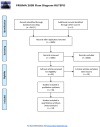Regulatory T Cells in Pregnancy Adverse Outcomes: A Systematic Review and Meta-Analysis
- PMID: 34777347
- PMCID: PMC8586555
- DOI: 10.3389/fimmu.2021.737862
Regulatory T Cells in Pregnancy Adverse Outcomes: A Systematic Review and Meta-Analysis
Abstract
Background: Several studies report the role of Regulatory T-cells (Tregs) in the pathophysiology of pregnancy adverse outcomes.
Objective: The aim of this systematic review and meta-analysis was to determine whether there is an association between regulatory T cell levels and pregnancy adverse outcomes (PAOs), including pre-eclampsia and preterm birth (PTB).
Method: Literature searches were conducted in PubMed/MEDLINE, Embase, and Cochrane CENTRAL databases. Inclusion criteria were original articles (clinical trials, case-control studies and cohort studies) comparing Tregs, sampled from the decidua or maternal blood, in healthy pregnant women versus women with pre-eclampsia or PTB. The outcome was standardised mean difference (SMD) in Treg numbers. The tau-squared (Tau²), inconsistency index (I²), and chi-squared (χ²) test quantified heterogeneity among different studies. Analyses were performed in RevMan software V.5.4.0 for Mac using a random-effects model with outcome data reported with 95% confidence intervals (CI). This study was prospectively registered with PROSPERO (CRD42020205469). PRISMA guidelines were followed.
Results: From 4,085 unique studies identified, 36 were included in qualitative synthesis, and 34 were included in quantitative synthesis (meta-analysis). In total, there were 1,783 participants in these studies: healthy controls=964, pre-eclampsia=759, PTB=60. Thirty-two studies compared Tregs in healthy pregnant women and women with pre-eclampsia, and 30 of these sampled Tregs from peripheral blood showing significantly higher Treg numbers in healthy pregnancies (SMD; 1.46; 95% CI, 1.03-1.88; I²=92%). Four studies sampled Tregs from the maternal decidua showing higher Tregs in healthy pregnancies (SMD, 0.76; 95% CI, -0.13-1.65; I²=84%). No difference was found in the number of Tregs between early versus late pre-eclampsia (SMD,-1.17; 95% CI, -2.79-0.44; I²=94%). For PTB, two studies compared Tregs sampled from the peripheral blood with a tendency for higher Tregs in healthy pregnancies but this did not reach significance (SMD, 2.18; 95% CI, -1.34-5.70; I²=96%). Subcohort analysis using Treg analysis (flow cytometry vs. qPCR vs. immunofluorescence tissue staining) showed similar associations.
Conclusion: Lower Tregs in pregnancy, sampled from the maternal peripheral blood, are associated with pre-eclampsia. There is a need for further studies to confirm a relationship between low Tregs and PTB. As the precise mechanisms by which Tregs may mediate pre-eclampsia and PTB remain unclear, further fundamental research is necessary to elucidate the underlying processes and highlight the causative link.
Systematic review registration: PROSPERO, identifier CRD42020205469.
Keywords: high blood pressure (hypertension); pre-eclampsia; pre-term birth (PTB); pregnancy; pregnancy adverse outcomes (PAO); regulatory T cells (Tregs).
Copyright © 2021 Green, Politis, Rallis, Saenz de Villaverde Cortabarria, Efthymiou, Mureanu, Dalrymple, Scottà, Lombardi, Tribe, Nicolaides and Shangaris.
Conflict of interest statement
The authors declare that the research was conducted in the absence of any commercial or financial relationships that could be construed as a potential conflict of interest.
Figures






References
-
- Preterm Birth. Available at: https://www.who.int/news-room/fact-sheets/detail/preterm-birth (Accessed April 26, 2021).
Publication types
MeSH terms
Grants and funding
LinkOut - more resources
Full Text Sources
Medical
Research Materials

